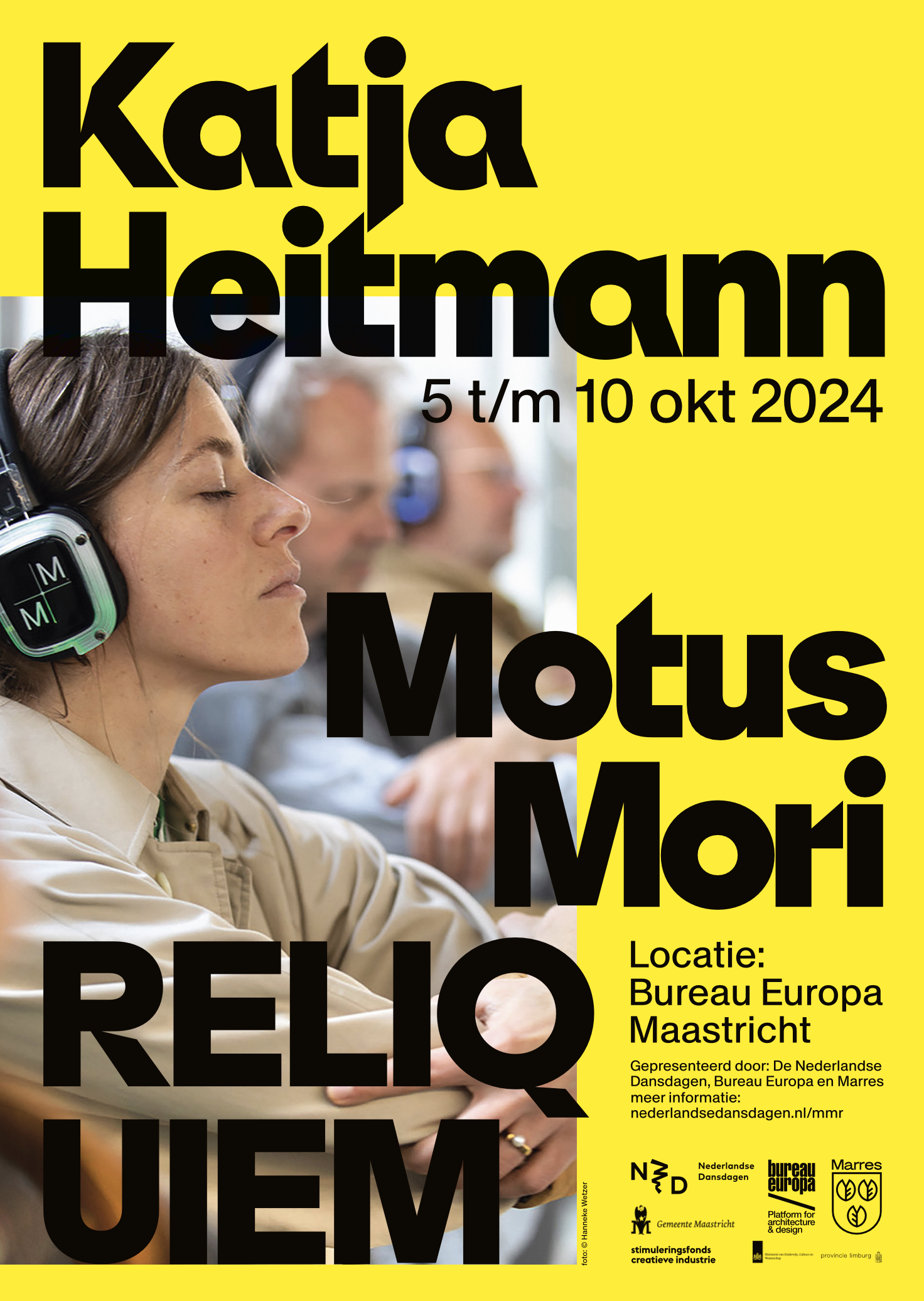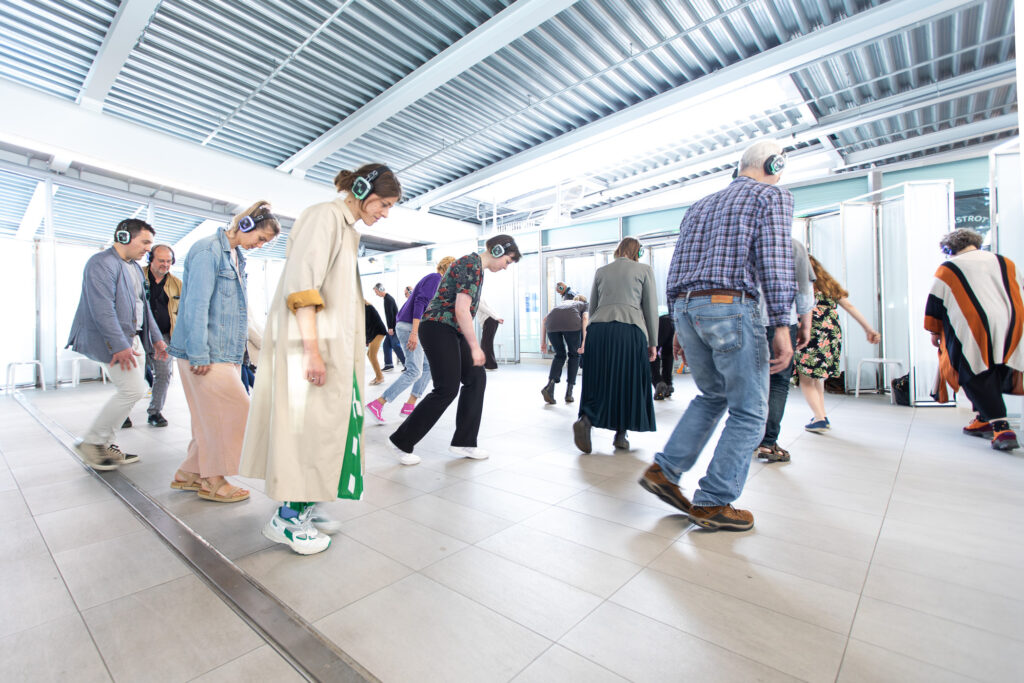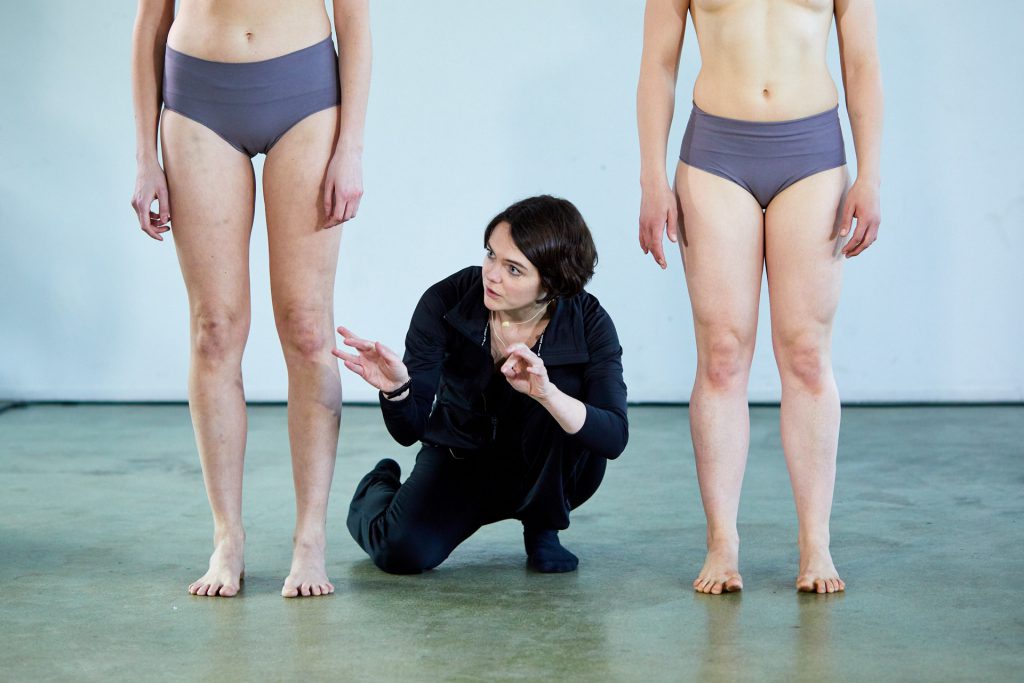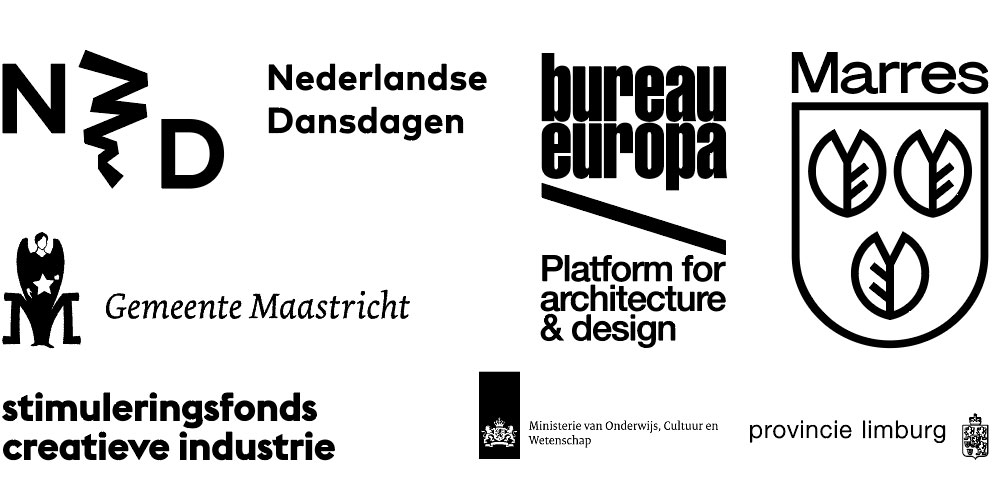
From October 5 to 10, Marres, Bureau Europa and de Nederlandse Dansdagen present the performance Motus Mori RELIQUIEM by German choreographer Katja Heitmann. Motus Mori RELIQUIEM is dedicated to human movement and will take place in the main hall of Bureau Europa in Maastricht.
What moves humankind? In Motus Mori RELIQUIEM, you experience other people’s motions in the most direct and touching way possible: through your body. You put yourself in the shoes of the archive’s many donors and incorporate their personal “movement relics” into your motion repertoire. Heitmann calls this “kinetic empathy”.
In the multi-year art project Motus Mori, Katja Heitmann collects and preserves human movement. Up to now more than 1900 people have already donated their personal movement to this embodied archive, an ever-growing foundation from which the choreographer creates new artworks. People from Maastricht and surrounding areas also donated their movement to Motus Mori in 2019. This year, the choreographer returns to the city with RELIQUIEM.
Katja Heitmann is fascinated by the human attempt to escape their own mortality. This paradox is the muse of the movement archive Motus Mori. As movement goes and vanishes, we are at the same time epi-central master of our own life and just a spark in eternity.
With RELIQUIEM, Katja Heitmann takes her archive research to the next level; creating a collective shared movement heritage to secure it for the future. The archive will be transferred to ‘everyone’. After all: doesn’t every human being want to keep moving, for eternity?
Dates and times
October 5 and 6, 2024:
10:30AM, 12:00PM, 2:30PM, and 4:00PM
October 7, 8, 9 and 10, 2024:
1:00PM and 7:00PM
Location
Bureau Europa
Boschstraat 9
6211 AS Maastricht
bureau-europa.nl

‘My mother died 12 years ago, my father last year. There is nothing left of them, no material belongings, no house, no will or farewell letter. Sometimes I manage to make a hand gesture that I recognize from my mother. Or my father’s shoulder-head-pupil-chin combination, a gesture that indicated he was struggling. Sometimes I see an older man walking down the street and suddenly I think it’s him. His tired body going on and on, back arched, shoulders hunched forward, while his head tried to look up. Often I wish I had observed them more closely, so I could keep their movement heritage alive.’
– Katja Heitmann
Background
For several years, Katja Heitmann has been working to create an archive for human movement. This is a question that is often raised in dance, since the discipline has no standardized notation. The body of a dancer, it is often said, is the archive of dance. But the same question also applies to the world outside dance. Our archives and museums collect portraits, objects, and writings but not the gestures and movements of important people. In our homes, we also save letters, objects, and photographs of our loved ones, but we lose the poses, movements, and reflexes that make them instantly recognizable. Katja Heitmann and her team make that loss tangible by collecting and preserving human movements.
In 2019, de Heitmann presented her project Museum Motus Mori at Marres. In this project, she created a museum of dying physical movement with ten dancers. For six weeks, five hours a day, the dancers and the choreographer took on the remarkable challenge of sensitizing visitors to the deep humanity hidden within the body. They developed a choreography for belly fat, a dance of the belly button and rib cage, the anatomy of a sigh…
Motion interviews
As a source, the choreographer used movement interviews. Every day people were invited to these interviews in which they told how they stood, sat or slept, whether they shared traits with family members, whether they had ever had an injury or accident that changed their physicality or movements. The dancers analyzed these traits and learned to embody them. Heitmann focused primarily on capturing involuntary human behaviors. She became fascinated by unconscious, sometimes transmitted movements, which are very awkward or make life difficult or arduous, but at the same time give a deep insight into human identity. The audience who witnessed this living archive saw a prolonged performance of human movements, including their own and those of their loved ones.

Biography Katja Heitmann
Katja Heitmann (1987, Germany) operates on the interface between dance and visual arts, performance and installation. In her visual-choreographic work, she investigates what moves people in the present era. In doing so, she always questions what it means to have a body, often in relation to rapidly advancing technology. In Homo Avatar (2016), she was inspired by the countless digital alter egos roaming the Internet. In Siri Loves Me (2017), a work she made with 50 young dancers, she wondered if technological advances and the surveillance that comes with them were going to hinder free movement. In Pandora’s DropBox (2018), she presented a disturbing image of the perfect man in a perfect world. Starting in 2019, Heitmann worked on various forms of her extensive Motus Mori project, an ode to the forgotten and even extinct movement. In 2016 Katja won the Prijs van de Nederlandse Dansdagen (Dutch Dance Days Award), in 2020 she was awarded the Gieskes-Strijbis Podiumprijs, the largest performing arts award in the Netherlands.

Press about Katja Heitmann
NRC
“In Museum Motus Mori, Heitmann collects, describes, archives and exhibits the minute movements we all make every day that immediately disappear again – the beauty and fragility of dance in one thoughtful concept.”
De Theaterkrant
‘Heitmann has a mission! Undeniably. In Motus Mori, she gives the body back to a society that is in danger of losing sight of its value. Art could not be more urgent. But beyond urgency, Reliquiem is also very moving. After all, the body is transient and confronts us with finiteness.”
De Standaard:
“It’s kinetic empathy at its best.”
De Volkskrant (Anette Embrechts)
“I recognized my ‘translated’ tics and gestures, whispers mixed with those of Pavel, Monika, Tosca and Herr Stamm. Highly original.”
The New York Times:
“Turning the gestures of everyday life into art.”
Museumtijdschrift (Edo Dijksterhuis):
“Museum Motus Mori is a kinetic portrait of all of us. And the way it takes shape, through the body rather than the mind, is more direct, effective and poignant than any video, photograph or text can ever be.”
For the press
For press requests, visual materials and interviews, please contact communicatie@marres.org.
Partners / thanks to

Motus Mori RELIQUIEM in Maastricht is a collaboration of Marres, Bureau Europa and de Nederlandse Dansdagen.
Marres receives structural support from the Ministry of Education, Culture and Science, the Province of Limburg and the Municipality of Maastricht.